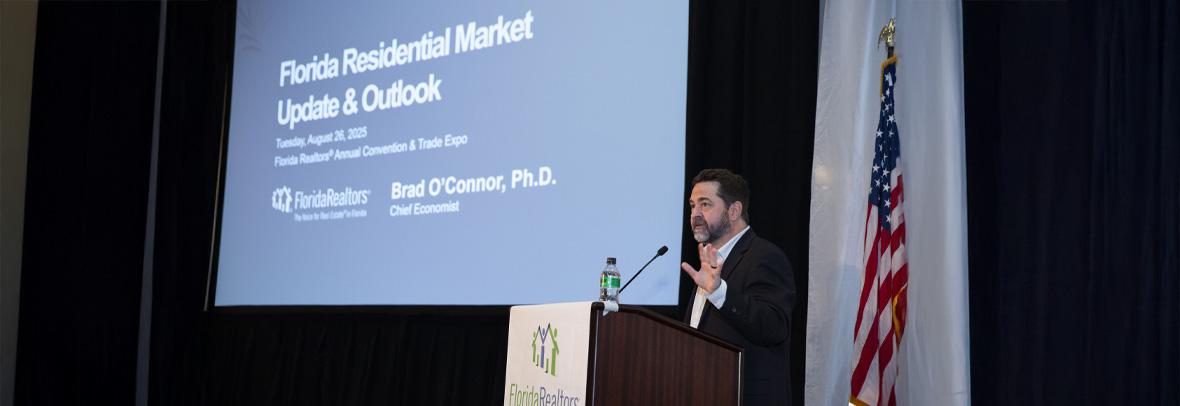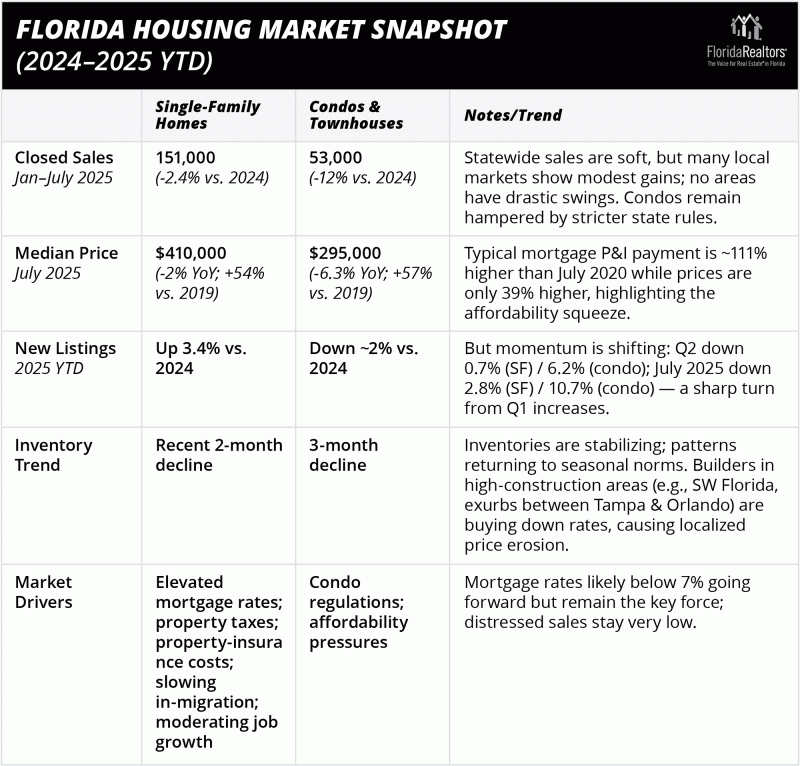
Florida Housing Holds Steady Amid Market Pressures
At the Florida Realtors Convention, Chief Economist Brad O’Connor said home sales remain slightly below last year's while prices stay well above pre-pandemic levels.
ORLANDO, Fla. — Florida’s housing market is showing signs of balance, with sales holding relatively steady and prices remaining well above pre-pandemic levels, according to data shared by Florida Realtors® Chief Economist Dr. Brad O’Connor during the 2025 Florida Realtors Convention in August.
Through July 2025, statewide sales remain slightly below last year’s pace, although local trends vary and prices, while easing, are still far above pre-pandemic levels. O’Connor’s presentation underscored that many local markets are holding steady, showing the market is adjusting rather than sharply declining.
“Single-family closed sales are up this year so far in many local markets around the state, so the statewide figure doesn’t necessarily reflect what’s happening locally,” O’Connor said. “There isn’t really any place that is seeing explosive sales growth or a drastic decline in sales.”
Single-family homes continue to see longer market times, contributing to the recent rise in inventory, O’Connor noted. Condo listings are somewhat elevated but remain near historical norms.
From O’Connor’s presentation, several other trends stand out:

O’Connor highlighted other factors as well:
- Mortgage payments: As of July 2025, the typical monthly principal and interest (P&I) payment for a new mortgage on the median-priced single-family home in Florida is about 111% higher than five years ago. At the same time, the median sale price is 39% higher. Rising mortgage rates have tempered demand. “The combination of elevated prices and mortgage rates has truly put a dent in affordability that has resulted in our lower level of sales,” he said. “We could see some improvement in mortgage rates if the spread between them and the 10-year Treasury yield continues to shrink toward a normal level.”
- Property insurance: Although recent increases have slowed, due to measures taken by the state Legislature on claim lawsuits and insurance fraud, insurance costs remain higher than pre-pandemic levels. This affects affordability and may be contributing to slightly higher out-migration. “We still have a lot more people moving here than leaving, but out-migration is higher than normal for us,” he said.
- Property taxes: The Save Our Homes amendment, which caps annual increases in assessed value for property taxes for homeowners’ primary residences at 3%, continues to favor long-time Florida homeowners. “Investors, first-time home buyers and movers from out of state are paying significantly more in property tax,” he said.
- Migration patterns: Domestic in-migration is gradually returning to pre-pandemic levels. More buyers are coming from western states (such as California and Texas), while fewer are moving from Rust Belt states (like Ohio, Michigan and Illinois) than in previous years. “The desire to move to Florida hasn’t waned – it’s just a much bigger challenge in terms of affordability,” O’Connor noted.
- Job growth: Florida’s nonfarm payroll growth remains above the national average at 1.3% annually, though the gap is narrowing. The country overall is growing at 1%. Unemployment remains low.
Despite affordability pressures, distressed sales remain rare, as most homeowners benefit from low, fixed-rate mortgages. O’Connor noted that mortgage rates will continue to influence market activity, shaped by federal debt, inflation, potential Fed rate cuts and broader economic conditions.
Key takeaway: The Florida market is adjusting rather than declining, with inventory rising due to longer selling times rather than a surge in new listings, particularly for single-family homes.
© 2025 Florida Realtors®
